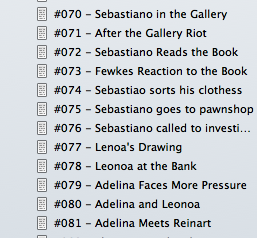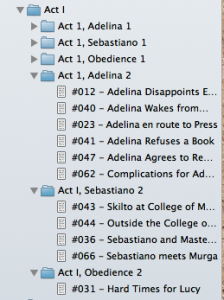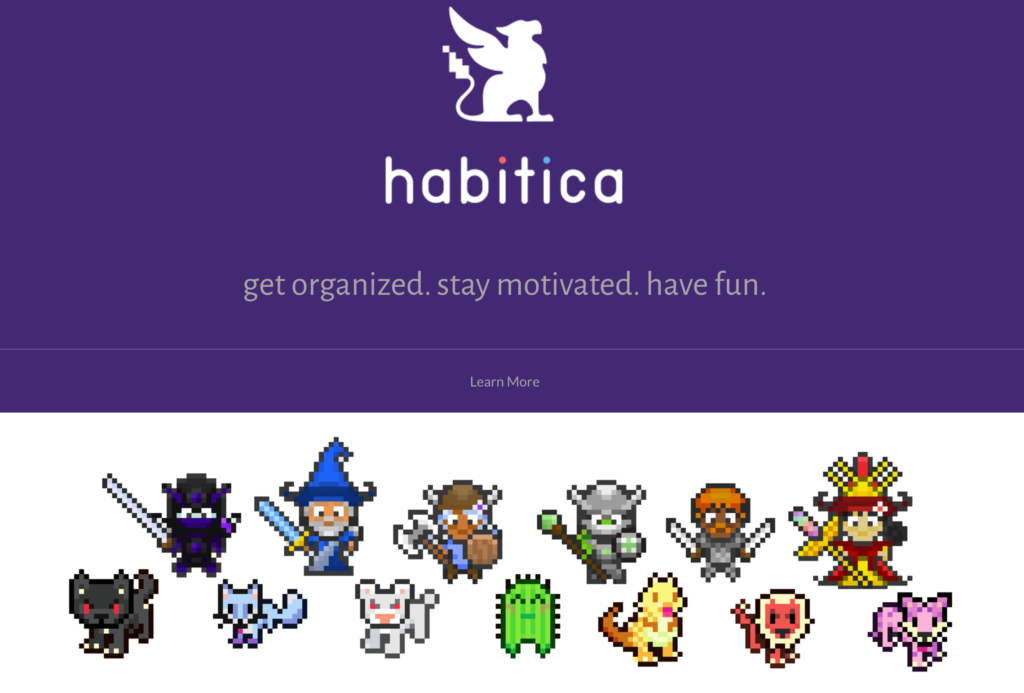Yesterday I got very little writing done, and instead worked on plotting. Ugh. I’ve reached that stage of the manuscript where I feel like I’m herding cats, and it seemed like time to make things make more sense.
Major Ingredients for Plotting
In starting, I had the following:
- a strong idea of each major character’s story arc
- the first book, which has some chronological overlap with volume 2
- a lot of scenes in various stages — some complete, some partial, some only notes, all contained in Scrivener
- a somewhat ragged and incomplete synopsis
And some things that made the process of plotting more complicated:
- Complication #1 to plotting: multiple POVs, including some episodes that overlap in time. Arranging these is much harder than you would think.
- Complication #2 to plotting: a couple of readers complained that the 1st book started slow. I wanted this one to grab and go.
- Complication #3 to plotting: a feeling that the POVs must be balanced to some extent.
Figuring Out the Overall Structure: the Sketchbook Method
So I printed out the synopsis and got out my big sketchpad. I wrote the three chronological points that were most important from the first book on the page, roughly where I thought they’d fall in the book: one at the very beginning, one about a quarter way through, and one about half the way through.
At first I divided the page into three sections for three acts, but by the time I was done, there were five sections total. I think of them as “acts” in that I want them to begin at an interesting point, have the right mix of scenes from the different POVs, and finish in a way that feels like a mini-ending, a chance to think about what’s gone before and to prepare for what’s coming up.

As you can see, that first page eventually ended up looking like a bit of a mess (and right now the image keeps showing up sideways, for some inexplicable reason that I cannot figure out at the moment), but it let me figure out where some things had to happen and realize that I had to nail down where a particular character from the first book is at all times.
I started working with colored pencils in order to track the different main characters, but that fell away as I began arranging what I already had. But it’s handy to be able to see the story from a high altitude, the 10,000 foot view, so to speak, particularly in terms of making the story make sense. Because while the writer can — and probably should deviate from a straightforward chronology for anything but the least complicated of stories — every time they do it, they place a demand on the reader to jump the hurdle and bounce along into the next scene with them.
As far as what’s been written, I have it in Scrivener, that most indispensable of tools. My process lately has been to work on individual scenes in nothing at all like chronological order, but more in the order of ones that really will be fun to write first (this approach has the drawback of inevitably arriving at a final sludge of scenes you didn’t want to write, but you will find at that point that at least half of them are actually not necessary.) So I began splitting up the pieces that were actually multiple scenes crammed in one document because they’d all been part of the same writing sprint, and numbering each one.

Breaking Things Down: Individual Acts
Taking my big sheet, I created a new one for each of the first four sections, and with each, tried to figure out the structure as far as the alternating voices went. I realized that what I had were two main points of view (Adelina and Sebastiano) and then a third one consisting of a brother and a sister (Eloquence and Obedience).
As I went through the manuscript, I began to sort the scenes into order, creating folders for the different POVs. While the scenes may not happen in the exact order they do in the folder, this gets me started putting scenes that will be close together into a single chunk.

Here are the individual act pages. As you can see, they’re messy and inexact, but they’re helping me sort out what goes where in a way that will then let me compile what I have into a document and start looking for the major holes, since filling them in is the next step.
Once I have those holes filled in, I’ll begin wrestling each chunk into a smooth form, and imposing a story arc of one kind or another on it.
Someone asked how I use Tarot cards in plotting. I use them as a way to figure out the major points and considerations for a scene or a chunk, by doing a simple Celtic Cross reading for the main character in that scene. If you’re not familiar with Tarot cards and that configuration for reading them, here’s better information on the spread, and I’ll blog sometime in the next couple days with a sample reading for a scene (but right now I should put in some actual ficiton wordcount).
Some SFWA and Class-related Stuff
In SFWA news, Todd Vandemark has put up the 1st of the videos he filmed at this year’s Nebulas, Steven Gould and I talking about joining SFWA. There will be new content on the channel released on a regular basis throughout the coming year, and I’m pleased to see that idea finally taking solid form.
Maggie Hogarth is onboard as the new Vice President and already hard at work. Look for some cool stuff coming up over the new year. 🙂
Finally, I’ve been doing some teaching from retreat and finding out that the wireless works fine. The Writing Your Way Into Your Novel class was terrific and gave me lots of ideas. This Saturday the 6 week Writing F&SF Stories starts. I’ve still got slots in that (as well as most of the other classes) and would be willing to talk about sliding scale or barter if you’re interested. If you’re interested, check out the list of classes here.








 One thing that was fascinating about this year’s Nebulas was the chance to meet so many people in the publishing industry, including a couple of the founders of Habitica, Vicky Hsu and Siena Leslie, who were on a panel about avoiding distractions – a key skill for a writer.
One thing that was fascinating about this year’s Nebulas was the chance to meet so many people in the publishing industry, including a couple of the founders of Habitica, Vicky Hsu and Siena Leslie, who were on a panel about avoiding distractions – a key skill for a writer.

20 Responses
You should check out Aeon Timeline. It is absolutley fantastic for keeping track of multiple story lines, seeing which character is getting all the action, etc. It works with Scrivener. http://www.scribblecode.com
Thanks, I will take a look at that!
you get 30 day trial like with Scrivener.
I tried Aeon. It was spiffy. I liked it. I tried to save my work. It crashed. I lost it all. It was so spiffy, I bought it after 30 minutes of use. Now I can’t use it because I can’t save anything I do. I’ve reported the crashes to them, but no updates (for Mac) have come forth. *sigh*
I didn’t have any issues when I was using it heavily. I’m still running Mavericks.
I’m on Mavericks as well. I need to see if there’s an update. I haven’t checked in a while.
One of the things that I love about it is that it allows the development of a consistent back story without pulling my hair out.
Great stuff, Cat. I love seeing how others use Scrivener. I love that tool.
Peggy Wheeler liked this on Facebook.
Jim Johnson liked this on Facebook.
J.t. Evans liked this on Facebook.
Shawn Scarber liked this on Facebook.
Great insight, Cat.
Esther Hazleton liked this on Facebook.
Andy Ainsworth liked this on Facebook.
Colleen Simpson liked this on Facebook.
I natter a bit about plotting – http://t.co/IaahgfFQ7D
RT @Catrambo: I natter a bit about plotting – http://t.co/j7rShOcxTM — Good stuff here!
Walt Socha liked this on Facebook.
Meryl Ferguson liked this on Facebook.